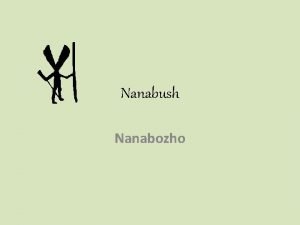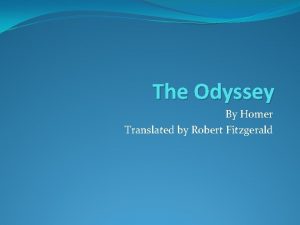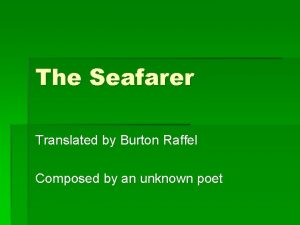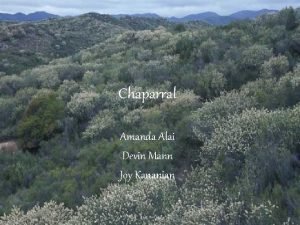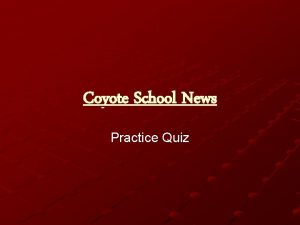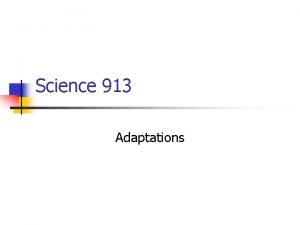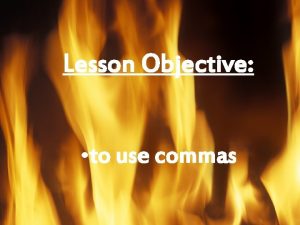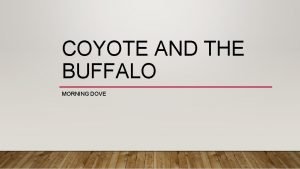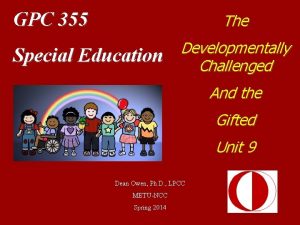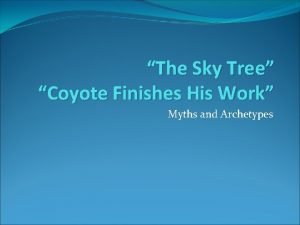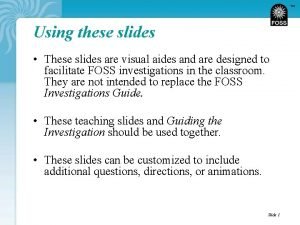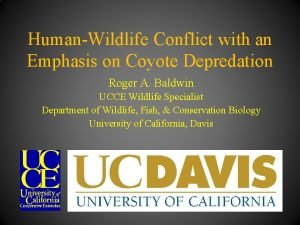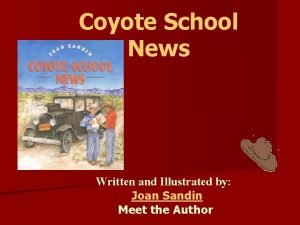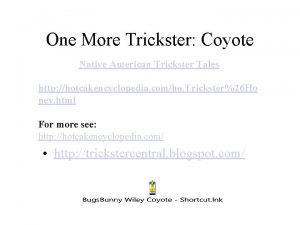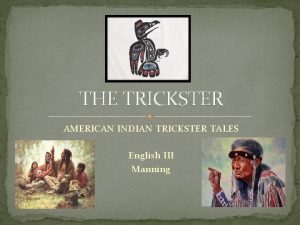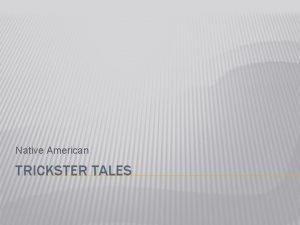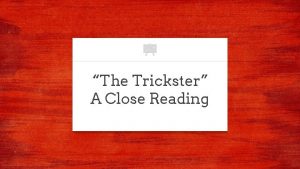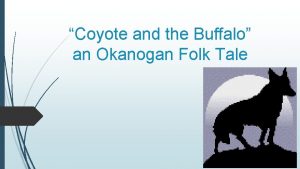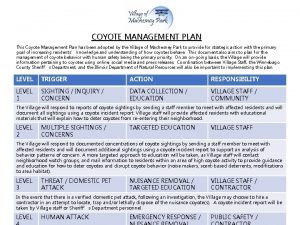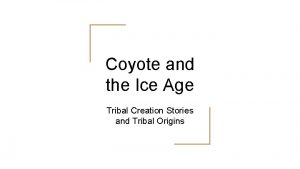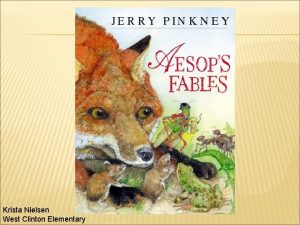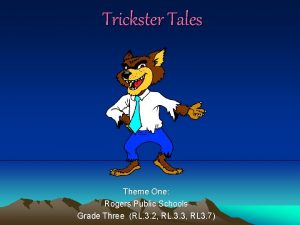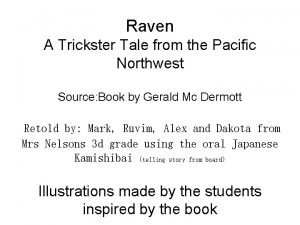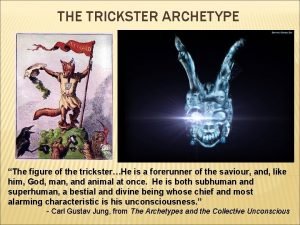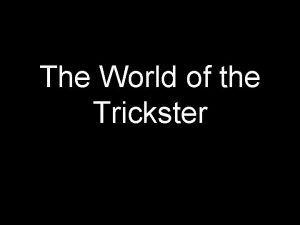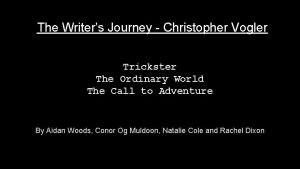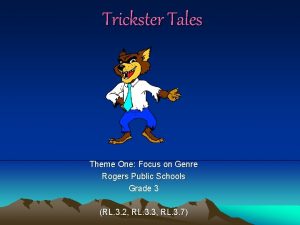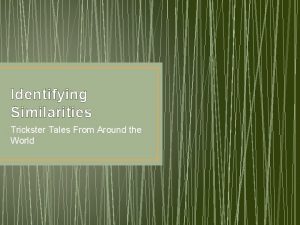Coyote Stories Okanogan stories of the Trickster translated
























- Slides: 24

Coyote Stories Okanogan stories of the “Trickster” translated by Mourning Dove

Mourning Dove • a. k. a. Christine Quintasket • Okanogan Indian • Lived from 1888 -1936

O K A N O G A N TRIBES

Okanogan tribes • Confederation of Native Americans of the Salishan branch of the Algonquian-Wakashan indians. • In the late 18 th cent. they numbered some 2, 500. In the early 19 th century they occupied an area extending from the west side of the Okanagan River in Washington north to British Columbia.

Continued… • In winter the Okanogan lived in semisubterranean earth lodges and in summer in mat or bark lodges. • They fished, hunted, and gathered roots and berries.

Trickster Tales • Trickster tales are common in Native American mythology. The Trickster is an animal character who defies authority and sometimes creates trouble. The Trickster often uses cleverness and wit to make up for his physical weakness.

The Trickster Coyote in Myth and Legend • A trickster character is one who tricks others in order to get his own way. • Most Native American tribes had trickster tales that they told with much amusement. • The Southwest Native Americans had thousands of coyote trickster stories.

Trickster Tales • A folk tale about an animal or person who engages in trickery, violence, and magic.

Characters There are not many characters, usually two. • One character is a good and clever trickster and one is a "bad" character. • The animals have human characteristics. • Talking animals are common in trickster tales.

Setting • The setting is often not important. • It is not fully described. • Time and place indicated with traditional phrases: "In a far away land, " "Once upon a time. "

Conflict • A strong character takes advantage of a weaker character. • The action may be repetitive, often in threes. • The strong character remains confident until the end.

Resolution • The weaker character will play a trick. • The solution is short and to the point. • The story may teach a lesson. • The story may explain why something occurs.

Trickster Characteristics • Standard features of the Trickster (a common figure in myths of many cultures) -often takes animal form -mischievous, greedy, selfish -tricks gods, often helps men or giants vs. gods • Examples: Coyote (American Indian), Spider (Africa), Monkey (China), Loki (Norse, Vikings, Scandinavia); Prometheus and Hermes (Greek myth)

Coyote Qualities • In some stories, he is a noble trickster, "Coyote takes water from the Frog people. . . because it is not right that one people have all the water. " • In others, he is mean, "Coyote determined to bring harm to Duck. He took Duck's wife and children, whom he (Coyote) treated badly. "

Theme • No sharp distinction is drawn between humans and the rest of the natural world. • This suggests that they had a philosophy that views humans in harmony with nature.

Muscogee Trickster Tale • Now Rabbit had a favorite place on the river where he always went to drink water. It was on a bend in the river, and two Snakes lived there, one on the upper side of the bend and one on the lower. Rabbit soon learned that neither of the Snakes knew that the other Snake lived there.

Ho, ho, thought Rabbit. I am going to have a bit of fun! Rabbit went to the Snake that lived on the upper bend of the river. “I am a very strong Rabbit, ” he told the Snake. “I bet I can pull you right out of the water. ” “I bet you can’t!” said the Snake, who was very strong indeed. “I will get a grapevine, ” said the Rabbit. “You will pull one end and I will pull the other. If I pull you out of the water, I win the contest. If you pull me into the water, then I win. ”

• The Snake on the upper bend agreed. Then Rabbit went to the Snake on the lower bend and made the same deal. He told both Snakes that he would be standing out of sight on top of the river bank and would give a whoop when he was in place and ready to start the contest. Both Snakes were pleased with the arrangement. They were sure they would win against such a feeble little Rabbit.

• Rabbit took a long grapevine and strung it across the wide bend in the river. He handed one end to the first Snake and the other end to the second Snake. Then he gave a loud whoop from the middle of the river bank and the two Snakes started tugging and pulling with all their might.

“That Rabbit is really strong, ” thought the Snake on the upper bank. He would tug and the vine would come a little closer to him and then he would nearly be pulled out of the water. “My, Rabbit is much stronger than he appears, ” thought the Snake on the lower bank after he was almost hurled out of the water by an extra strong pull from up the river.

• Rabbit sat on the bank above both Snakes and laughed. The Snakes heard him laughing and realized that they had been fooled. Letting go of the rope, they swam to the middle of the bend and met each other for the first time.

Both Snakes were angry with Rabbit for making them look foolish. They agreed that Rabbit could no longer drink from his favorite place on the river bend where they lived. In spite of his protests, they sent Rabbit away and would not let him come down to the riverbank anymore. So whenever Rabbit grew thirsty, he had to turn himself into a faun in order to get a drink from the river.

After that, Rabbit decided not to play any more jokes on Snakes.

Oral tradition • Passed on by word of mouth through generations with very little change.
 Coyote stories mourning dove
Coyote stories mourning dove Nanabush and the rabbit
Nanabush and the rabbit The odyssey by homer translated by robert fitzgerald
The odyssey by homer translated by robert fitzgerald Lahore resolution 1940 main points in urdu
Lahore resolution 1940 main points in urdu Estou bem graças a deus translated in english
Estou bem graças a deus translated in english The seafarer burton raffel
The seafarer burton raffel Translated
Translated In fair verona where we lay our scene translation
In fair verona where we lay our scene translation Hoogle domains
Hoogle domains Verb to have
Verb to have Coyote brush adaptations
Coyote brush adaptations Attendance
Attendance Coyote structural adaptations
Coyote structural adaptations Coyote brings fire answer key
Coyote brings fire answer key Coyote and the buffalo text analysis answers
Coyote and the buffalo text analysis answers How to clean canada goose badge
How to clean canada goose badge Acorn squirrel crow coyote energy pyramid
Acorn squirrel crow coyote energy pyramid Can wile e coyote talk
Can wile e coyote talk Coyote archetype
Coyote archetype Fox coyote and whale
Fox coyote and whale Characteristics of food web
Characteristics of food web Coyote roundup snare
Coyote roundup snare 187 meaning
187 meaning The sky tree summary
The sky tree summary Panda shape poem
Panda shape poem

